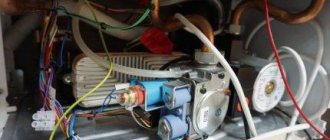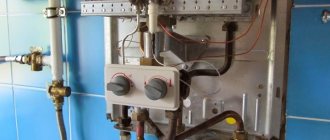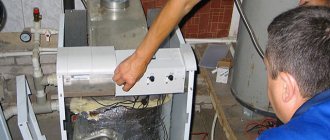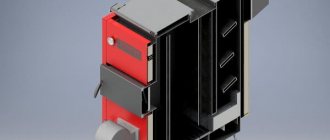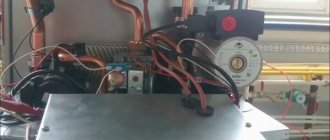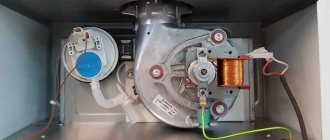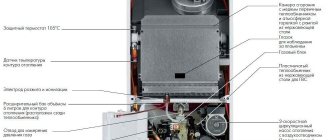Gas boilers are simple and easy to use, do not cause problems during maintenance, and effectively cope with their functional task. They are bought much more often than their electric and solid fuel counterparts, but not everyone knows that before turning on a gas boiler in an apartment or private house, preparatory measures need to be carried out.
In the article we present you will find useful information about starting a gas unit and the rules for preparing it for the upcoming work. We will talk about the features of filling the heating circuit with water. We'll show you how to enable and select the settings you need.
Pre-launch process
The sequence of actions to prepare for startup depends on the type of gas boiler being installed. It can be single-circuit or double-circuit, with a closed or open combustion chamber, floor-mounted or wall-mounted. The first launch is always associated with an increased level of responsibility and risk, so it must be carried out in compliance with all the nuances and subtleties.
The instructions for the gas boiler contain simple explanations according to which you need to start a specific model. The gas boiler must by this time be connected to communications in accordance with the agreed project. The first start-up is carried out after connecting the heating system into a single whole and installing equipment, radiators, and pipes.
Gas boilers with a closed combustion chamber do not require a large chimney. Also, their positive characteristic is the ability to be located close to the wall with a gap of 2 cm, which allows you to save space in the apartment
According to fire safety rules, the gas boiler should be located in places protected from the possibility of ignition, away from flammable objects and materials. In this case, the heating unit should be located at a certain distance from the wall and floor. The exact distance value is individual for each boiler and is indicated in the instructions.
Wall-mounted models are hung on anchors so that there is a small gap between them and the plane of the wall. The boiler must be installed strictly exactly at the water level. Distortions and tilts of the equipment are unacceptable.
After installing the gas boiler to the wall, it is necessary to connect the device to the pipe supplying cold water. To do this, you need to remove the plugs from the receiving pipes.
In addition, a coarse water filter and a mud filter are installed at the inlet of communications to the boiler, which will protect the internal pipeline of the unit from clogging and sedimentation. Ball valves are installed on all pipes when piping.
Installing and running pipes to the boiler is an important task. The end result should not only be beautiful and aesthetically pleasing, but also provide easy access to key parts of the system
Before starting the boiler, an important step is to install a gas pipe to it. This work cannot be carried out independently. You will have to invite craftsmen from the GorGaz branch with which you have a service agreement.
Gas workers will calculate the required length of the pipe, lay it, install a gas meter and seal it. In order for the device to work for a long time and not smoke, you need to take care of the supply of good gas.
Also, for a gas boiler, for safety reasons, it is advisable to install a separate power line with its own automatic circuit breaker installed at the entrance. A socket should be placed close to the device, at a distance of 30-50 cm from the body. Grounding must be done; it will protect users from receiving electric shocks in the event of a breakdown on the housing.
Reliable and high-quality pipes are the key to the longevity of the heating system. You should buy pipes and radiators only from trusted manufacturers. A cheap product in this case will only bring problems
A boiler installed in a private house is equipped with its own chimney. It should go outside through the wall or through the attic space to the street. The chimneys of boilers in city houses up to five floors are connected to a public smoke shaft.
Depending on the specific device, the amount of work required to install the chimney varies. Some devices with a closed chamber are also equipped with a pipe to supply air to the combustion zone.
Upon completion of all preparatory work, you need to fill the heating system and the boiler itself with cold tap water. After filling, the system is checked for leaks. Then a remote control panel and a thermostat are mounted on the wall, to which temperature sensors are connected.
Features of filling the system with water
Before you ignite the gas boiler and activate the system, you need to properly fill the heating system and all its elements with water. To begin filling the heating equipment and the circuit connected to it with water, first disconnect the boiler from the power supply. We still need to turn off the gas supply.
Next, you need to turn on the water by opening the valve or tap that supplies cold water, as well as the make-up tap located at the bottom of the boiler. The exact location of the make-up tap is indicated in the instructions for the device.
The technician checking the system must definitely go around all the rooms along the pipes and radiators and check them for the presence of water leaks. If a leak is detected, you need to shut off the water supply and begin to fix the problem.
Before filling the system with water, you need to make an additional bypass of all heating devices and make sure that all connections are tight and tight.
You can drain the water from the system completely or shut off the corresponding link. Then you need to unscrew the leaking pipe connection, drain the water or screw in the plug. Afterwards, the necessary material and tools are prepared, the plugs are unscrewed, and the pipe is tightly reconnected to the radiator using sealant. Next, you need to check the tightness of the system again.
The intake of water is accompanied by a characteristic sound. It is important to unscrew the valve slowly and gradually, avoiding sudden movements. If you open the tap suddenly, there is a high probability of air pockets occurring. Simultaneously with the system being filled with water, the gas boiler pressure gauge shows the current pressure in the system.
The operating pressure must be found in the instructions for using the boiler. When the pressure reaches the operating range, you need to stop the water supply by closing the valve. Typically, the operating range of the boiler is a pressure value of 1.5 - 2 atmospheres.
It is recommended to fill the system with water in the warm season. If the temperature outside is sub-zero, you should preheat the room using a portable radiator to about 20 degrees Celsius.
Removing air pockets
Upon completion of the filling stage, the system must be checked for air pockets, excess air must be bled off and, if necessary, cold water must be added. If you do not bleed off excess air, the radiators will not heat up enough, since there will be a space in them that is not filled with heated coolant.
The Mayevsky tap is a simple device that is a needle valve. It is used to bleed air from the batteries.
To make the first start successful, you should go around each radiator with a screwdriver or other tool and bleed the air from the heating devices. Some batteries are equipped for this procedure with an air vent, a Mayevsky valve, which can be controlled by hand.
The air from the pipe system and the heating devices connected to it is drained until water flows. While the air flows, a characteristic hissing sound is made.
For convenience, it is worth preparing in advance a basin or ladle into which the water will be drained, as well as a rag, which is then carefully used to cover the stream of water so as not to stain the wall or nearby appliances. After the air has been released, you need to tighten the radiators tightly so that water does not leak from them.
Modern boilers are equipped with devices that allow you to automatically remove air pockets from the heating system. However, such devices do not always effectively cope with the task assigned to them. Therefore, you often have to bleed the air manually.
Having completed bleeding the air from the closed heating circuit, they begin to fill the space freed from air pockets with water. Without this operation there will be no working pressure in the system, because it is not filled enough.
To replenish the circuit with water, connect the unit to the power supply, open the feed tap and press the “Power” button. In this case, the pump should start and the boiler burner will try to ignite. However, after a couple of seconds, the electronics will block all attempts, and the display will display an error code, because gas does not flow to the injectors.
This procedure will need to be repeated several times. It will be necessary to recharge until all the air comes out of the pipes and devices of the boiler, as well as the circuit connected to it. When the stage of filling the system and freeing it from air pockets is completed, you need to check the pressure and open the gas supply.
The circulation pump ensures the movement of the coolant. The manufacturer is prohibited from performing any manipulations with it independently, otherwise the warranty obligations automatically become void. If the pump breaks down, simply replace it
Before igniting the boiler, the gas engineer carefully checks that the connection diagram corresponds to the design solution on the basis of which it was assembled. The technician once again makes sure that the pressure in the system corresponds to the parameters recommended by the manufacturer. Tests the tightness of all communication lines and their connection points.
Checking and flushing the system
In order to ensure the high quality of the work performed and prevent possible water leaks, plumbers recommend performing a pressure test of the system before starting the boiler. This procedure will require expensive equipment - a pressure pump. However, there is no need to buy it, as it will only be needed for half an hour to check the system.
You can borrow such a device from friends or rent it. You can also use the service of an on-call technician who will independently check the system and correct any problems that have arisen if necessary.
The purpose of pressure testing is to identify leaky areas of the system and eliminate them. A system that has gone through this process is guaranteed to serve for a long time and will not fail at the most inopportune moment.
There are two methods of crimping: with a water column or with compressed air. The essence of the procedure is pumping air or water into the system to establish a pressure level in it approximately one and a half times higher than the working one. After pumping, it is necessary to record the pressure value on the pressure gauge and wait 10 - 15 minutes.
Before performing pressure testing, it is important to take into account the characteristics of all elements that make up the heating system. In addition to checking the functionality of the system, it is also important not to damage its structural elements with excessively high pressure.
If at the end of this period of time the pressure remains at the same level, then the system is considered pressurized and has no leaks. If the pressure has dropped, then you need to identify the place where water is leaking and eliminate this problem. Then carry out the procedure again.
Please note that before installing a new unit, flushing a circuit that has been in operation for several years must be done. All ]gas equipment[/anchor] warn that installing a gas boiler in an old circuit that has not been cleared of mineral deposits is prohibited. Failure to comply with the rule will result in the boiler owner losing his warranty.
This process is carried out in two stages. Initially, rough washing is carried out. In this way, the largest contaminants are removed. The pressure in the system when flushing should be about 3.5 atmospheres. After the water is agitated under pressure, it is released from the system through a drain valve.
In this case, the coarse filter often becomes clogged. It may need to be washed once or twice. Finish washing is carried out using pressure pumps.
After finishing washing, you need to check the coarse filter. It must be uncontaminated. Supplying contaminated water to the boiler is highly undesirable
After completing the preparatory work, you can start launching the device.
Tips for restoring the device
After unlocking, you should bleed the air from the radiators in every corner of the house where there are taps.
Don't forget about the heated towel rail: it may have such a tap. If there is an automatic valve on the heating, you need to loosen the cap to bleed air.
You should check the pressure in the system again; it should be at least 1.5 bar at the initial stage of operation. When heating, the desired pressure value is up to 2.5 bar, since too high a value damages the system elements responsible for the connections and leads to its overload.
Turning on the gas boiler
A prerequisite for warranty service of a gas boiler is that the first switch-on must be carried out exclusively by a specialist from the gas service. If the user follows all instructions and safety precautions when starting up independently, then you can also count on the reliability and durability of the heating system.
The initial start-up of a wall-mounted boiler is carried out strictly after checking the following points.
The first thing you need to do is make sure that the gas pipes are tight when the gas valve is closed and open. If gas flow is not recorded within 10 minutes after connecting all pipes, then it can be stated that the system is sealed.
The gas supplied from the main pipeline must meet the requirements specified in the instructions for the boiler. When transferring the unit to process a liquefied mixture, you need to change the nozzles in advance.
You also need to check the pressure level in the system. It should be as recommended. The air intake and carbon dioxide exhaust pipes should be checked for blockages.
Sometimes users encounter the problem of poor circulation of the pump. Often the cause is low mains voltage. This problem is solved by installing a stabilizer
It is necessary to make sure that the room with the boiler has a working ventilation system. Additionally, the smoke pressure safety switch is checked.
After carrying out the preliminary work, the procedure for starting the boiler follows:
- The gas boiler is connected to the network, the gas supply to the device is opened;
- Check that all valves at the inlet and outlet of the coolant into the unit are open;
- Press the button or turn the switch on the boiler dashboard depending on the switching method specified in the instructions.
You can adjust the temperature using the corresponding buttons. Working in automatic mode, the boiler independently turns on the burner if it is necessary to heat the water in the system. If the boiler is double-circuit, then when hot water is turned on, the burner automatically turns on for heating.
On the boiler display, after the initial start-up, it is recommended to configure all boiler parameters. The instructions usually indicate the sequence of necessary actions.
The interlock system cuts off the gas supply if the burner does not ignite within approximately ten seconds. When starting for the first time, it may be necessary to remove the ignition lock due to the presence of air in the gas line. You need to wait until the air is replaced by gas. The lock is removed when the device is restarted.
To start a floor-standing gas boiler, you need to carry out the same preparatory procedures as for a wall-mounted one. Before starting up, you need to ventilate the boiler room, make sure that all heating pipe taps are open and that there is draft in the chimney. You can check the traction using a piece of paper.
There are two options for turning off a floor-standing gas boiler. You can turn off only the main burner or the main burner together with the pilot
Switching on the floor-standing boiler:
- The door of the device is opened, the position of the boiler control knob is checked in the off position.
- The gas supply valve opens.
- The control knob is set to the piezo ignition position.
- Next, press the handle for 5 - 10 seconds so that the gas passes through the pipes and displaces the air. The piezo ignition button is pressed.
- Then the presence of a flame in the burner is checked. If the burner does not light, the procedure is repeated.
After igniting the main burner, you can use the control knob to adjust the heating temperature.
Washing and crimping
Both operations are rarely performed. Although according to the standards, pressure testing must be performed once a year. Flushing will occur accordingly. The purpose of the operation is to increase the pressure inside the network in order to identify areas that may be subject to depressurization.
To do this, use a special pressure test pump, with which tap water is pumped into the heating system. Its pressure should be 25% higher than the standard (here we mean coolant pressure). The heating remains in this state for 10-20 minutes. If there are no changes, the pressure testing is considered completed, and the network is in technically sound condition. This also applies to a gas boiler.
Washing is a simple process. A special device is used for this - a booster. Essentially, this is a container with a compressor. A chemical liquid solution is poured into it, to which abrasive particles are added. The mixture is driven under pressure through the utility network, purifying:
- pipes;
- radiators;
- cavities of shut-off valves;
- gas boiler heat exchanger;
- expansion tank, other components and parts.
Booster for flushing the heating system
Important Operating Instructions
In terms of operation, gas boilers with a closed combustion chamber are considered safer. Their firebox does not communicate with the room air. However, the power of such boilers is significantly inferior to the power of boilers with an open combustion chamber. Therefore, in private households a second type of boiler is often installed.
The choice of future coolant depends on the goals and operating conditions of the system. If the boiler is expected to be turned off frequently, then it makes sense to think about using antifreeze
The operation of such boilers requires compliance with safety precautions. So, to install a powerful floor-standing boiler, it is customary to use a separate room with a certain size. The boiler is mounted at some distance from the walls. Nearby walls should be protected with fire-resistant material to prevent fire.
A ventilation system must be installed in the boiler room. There should also be a source of natural light. The width of the entrance door must be at least 80 centimeters. The chimney is laid in accordance with the instructions for the boiler and from heat-resistant material. The chimney must rise above the roof ridge by at least half a meter.
One safety measure is to install carbon monoxide detectors. The gas detector will promptly detect the leak of a volatile toxin and warn users about it. It can also be configured so that the ventilation is automatically turned on and the gas supply is turned off. Modern automation allows the implementation of a variety of smart systems.
If the temperature, pressure or gas sensor fails, you must immediately turn off the boiler and call a service technician. Using a boiler without these devices is fraught with serious negative consequences.
SNiP requirements state that a gas boiler must be connected to the main line using a copper pipe or a bellows hose. In this case, a faucet must be installed
If signs of a gas leak are detected, you must immediately turn off the gas tap and open the windows to ventilate the room. Do not turn on the light and try to illuminate the room by lighting matches or a lighter.
The gas boiler must be serviced at intervals specified by the manufacturer. Information about the necessary procedures is indicated in the instructions for the device. For example, you need to clean the chimney, remove scale from the heat exchanger, or clear the fumes from the burner. Then the boiler will last a long time, and the risk of serious malfunctions will be significantly reduced.
When using a gas device, do not turn it on at maximum power for a long time. This may result in the release of steam, which is unacceptable.
Sometimes the boiler begins to make unusual noises and vibrations. This may be due to the operation of the fan. We warn you that all actions that require disassembling the boiler casing automatically deprive the owner of the right to warranty repair or replacement.
However, the owner of the unit needs to monitor the operation of mechanisms and systems that protect the boiler from fire. It is necessary to maintain the temperature in the circuits at around 50 degrees, which significantly reduces the likelihood of mineral deposits forming on the internal surfaces of pipes and devices.
Solid fuel unit
Before starting the heating system, check the condition of the boiler operating on solid fuel. It is necessary to clean its surface from rust and make sure that devices such as thermometers and pressure gauges are working.
Then a series of works are performed:
- Clean the combustion and ash chambers from soot using a metal brush.
- Check the condition of the chimney - its pipe must be securely connected to the unit's branch pipe.
For pyrolysis and pellet devices, the functioning of the electronic control unit, nozzles and fans must be tested. When heating is started, if these elements do not work correctly, sudden temperature changes may occur, which will directly affect the condition of other components.
It is prohibited to store flammable substances in the room where the solid fuel unit is installed. To store fuel, you should arrange a separate utility room or build an extension.
Reviews
Zh7-KS-GS-7.0 S: Roman G., Shakhunya
The main advantages are low cost and compactness. The disadvantage is that it sometimes goes out and does not flare up the first time. After listening to the advice, we bought a Taiga and described the boiler as reliable. In fact, it turned out that there were a lot of problems. The most unpleasant thing is to light it. It happens that you light the wick several times until the burner lights up. The wick goes out on its own. Dissatisfied with the choice.
KS-G-12.5 DS: Victoria E., Bryansk
We have long wanted to replace the old-style boiler with a more manageable and economical one. We chose the floor option. We have a boiler, so we installed a single-circuit boiler. I was attracted by the cost and simplicity of the design. It does not have super functions, like its European counterparts, but it works properly. There were no problems during the season. A powerful device capable of heating our large house in the most severe frosts.
Gas heaters "Taiga" are an advantageous offer in the segment of parapet-type devices. They combine an affordable price with high performance characteristics. This inexpensive and unpretentious device operates smoothly in the harshest climatic conditions. All lines of equipment from Termotechnik are reliable, energy efficient and are in deserved demand among domestic consumers.
About the manufacturer
The Signal trademark is managed by Signal-Teplotekhnika LLC, which has been specializing in the production of heating equipment for more than 17 years. The company is also represented in the form of dealer networks in the markets of Kazakhstan and Belarus. In the Russian market, it has established itself as a manufacturer of some of the most inexpensive classic budget gas floor-standing boilers, both single-circuit and double-circuit. The earliest boilers are no longer found in homes, but you can often find examples that last 12-14 years.
In general, these are excellent and reliable models for home use; they have good efficiency and average gas consumption, trouble-free Italian automatics and burners. However, it is important to understand that it is not worth expecting anything from the simplest design in terms of durability. In its models, the manufacturer, like many others in this price segment, uses heat exchangers made of good, but rather thin steel (standard 3 mm).
The device using the example of a double-circuit S-Term signal. The simplest design of the heat exchanger and gas exhaust, lack of heat and sound insulation, minimum controls.
Steel, even despite high-quality anti-corrosion coatings, is vulnerable to corrosion and after 10-15 years it completely rusts and collapses, which leads to leakage of the heat exchanger. Typically, the service life depends on operating conditions: if you use clean and soft water as a coolant, change it as rarely as possible, the service life can reach 14-15 years; otherwise, cases of leakage after 8 years of operation are not uncommon.
There are other drawbacks - the assembly is of insufficient quality, consumers note that during operation there may be problems with the automation, due to the simplicity of the device and low cost, the boilers do not have a wide range of functionality or a set of protective systems. Installers note the relative complexity of installation and connection.
The device using the example of a dual-circuit Signal Comfort. A reinforced heat exchanger, turbulators that slow down the exhaust of gases, the design is still simple, and the functionality of the controls is limited.
Separately, it is worth noting the non-standard diameter of the gas inlet pipe - 1/2″ instead of the standard 3/4″, so when replacing an old boiler with a new one, you will most likely have to pay an additional 500-1,000 rubles. more for installation and connection.
However, almost all of the above-described disadvantages are typical for any inexpensive boilers of Russian, Ukrainian or Belarusian production.
How to choose a room thermostat and save up to 30% per month on heating
Method for finding a breakdown
First of all, you need to start checking the gas sensor. It is the weakest element of the gas boiler automation system. Due to the fact that the sensor is not protected by a casing, after about a year it becomes covered with a thick layer of dust. As a result, the bimetallic plate oxidizes and thus the contact deteriorates.
Dust can be removed with a soft brush. Next, you need to pull the plate away from the contact and clean it with fine sandpaper. But it is worth remembering that you need to clean the contact. After the contact and plate have been cleaned, a thin layer of liquid lubricant must be applied.
Then it is necessary to check the serviceability of the thermocouple. The service life of this element is much shorter than others, since it is in the pilot flame and is exposed to high temperatures. The main failure of a thermocouple is burnout of the housing. When burnout occurs, the contact resistance at the junction increases. And the bimetallic plate will become lower than the required value and the electromagnet will no longer be able to fix the rod.
Prices: summary table
| Model | Power range, kW | Range of maximum gas flow, m3/hour | price, rub. |
| Series "S-Term" | 7 — 25 | 0,85 — 2,98 | 18 000-25 000 |
| Series "Comfort" | 10 — 50 | 1,19 — 5,95 | 25 000-29 500 |
| High power boilers KOV ST and STPV | 63 — 150 | 5,95 — 18,24 | 53 200-120 000 |
Ways to solve the problem
The problem can be solved in ways that require significant investment, for example:
- using an indirect heating boiler together with a boiler,
- purchasing a new boiler with a built-in boiler.
However, there is a less expensive, but very productive method - inserting an electric storage heater into the hot water supply circuit. Moreover, for this purpose, any standard heater with a volume of 30 liters is quite suitable, regardless of the manufacturer.
Parapet
In addition to floor models, the manufacturer offers parapet versions for heating chimneyless housing. May vary in shape, size and design of the case. Installation is possible anywhere - on the floor or on the wall. Closed firebox. The burners are installed in different ways: single-level, two-level or modulating.
Heat exchanger materials: cast iron, copper, steel. In Taiga they are made of steel. Gases are removed through a coaxial chimney. Any ignition - piezo or electronic. Sensors and controllers ensure uninterrupted and safe operation. Termotechnik produces 3 parapet series with a power of 7–16 kW:
All modifications have an ergonomic and stylish design, high technical characteristics. Heat exchangers are treated with anti-corrosion powder coating. The powder contains no toxic or flammable substances.
Features of parapet models
They are used for heating and for heating hot water. Power is 15–45 kW. A parapet heating boiler is a chimneyless, energy-independent device, used primarily for heating households and apartments that do not have traditional chimneys. The main difference between any parapet model is the closed firebox. The latter is isolated, so during operation the air of the room where the equipment is located is not used.


